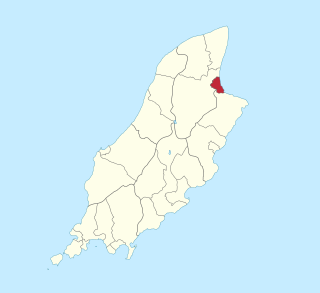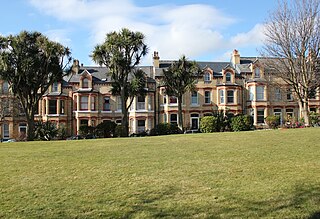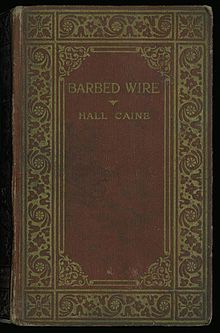
Sir Thomas Henry Hall Caine, usually known as Hall Caine, was a British novelist, dramatist, short story writer, poet and critic of the late 19h and early 20th century. Caine's popularity during his lifetime was unprecedented. He wrote 15 novels on subjects of adultery, divorce, domestic violence, illegitimacy, infanticide, religious bigotry and women's rights, became an international literary celebrity, and sold a total of ten million books. Caine was the most highly paid novelist of his day. The Eternal City is the first novel to have sold over a million copies worldwide. In addition to his books, Caine is the author of more than a dozen plays and was one of the most commercially successful dramatists of his time; many were West End and Broadway productions. Caine adapted seven of his novels for the stage. He collaborated with leading actors and managers, including Wilson Barrett, Viola Allen, Herbert Beerbohm Tree, Louis Napoleon Parker, Mrs Patrick Campbell, George Alexander, and Arthur Collins. Most of Caine's novels were adapted into silent black and white films. A. E. Coleby's 1923 18,454 feet, nineteen-reel film The Prodigal Son became the longest commercially made British film. Alfred Hitchcock's 1929 film The Manxman, is Hitchcock's last silent film.
Gerhard Bersu was a German archaeologist who excavated widely across Europe. He was forced into exile from Germany in 1937 due to anti-Semitic laws in pre-war Nazi Germany. He was interned on the Isle of Man during World War II where he made several significant archaeological discoveries such as the Viking boat burial at Balladoole.
In customary international law, an enemy alien is any native, citizen, denizen or subject of any foreign nation or government with which a domestic nation or government is in conflict and who is liable to be apprehended, restrained, secured and removed. Usually, the countries are in a state of declared war.

The Poston Internment Camp, located in Yuma County in southwestern Arizona, was the largest of the 10 American concentration camps operated by the War Relocation Authority during World War II.

Stanley Internment Camp was a civilian internment camp in Hong Kong during the Second World War. Located in Stanley, on the southern end of Hong Kong Island, it was used by the Japanese imperial forces to hold non-Chinese enemy nationals after their victory in the Battle of Hong Kong in December 1941. About 2,800 men, women, and children were held at the non-segregated camp for 44 months from early January 1942 to August 1945 when Japanese forces surrendered. The camp area consisted of St Stephen's College and the grounds of Stanley Prison, excluding the prison itself.
Kenichi Zenimura was a Japanese-American baseball player, manager, and promoter. He had a long career with semiprofessional Japanese-American baseball leagues in the western United States and Hawaii; these leagues were very active and popular from about 1900 to 1941. He is also noted for the successful barnstorming tours he organized that brought famed players such as Babe Ruth and Lou Gehrig to the west coast and to Japan for exhibition games in the 1920s and 1930s. Along with most Japanese-Americans living on the west coast of the United States, during World War II he was incarcerated with his family in an internment camp. Their camp was the Gila River War Relocation Center in Arizona. There he led construction of a complete baseball field including spectator stands, and he organized baseball leagues for the internees. These leagues were important both to the morale of the internees and to building relationships with nearby Arizona residents. Zenimura has been called the "Father of Japanese American Baseball".
Knockaloe railway station served Knockaloe Internment Camp in the Isle of Man between 1915 and 1920.

The Torrens Island Internment Camp was a World War I concentration camp, located on Torrens Island in the Port River Estuary near Adelaide in South Australia. The camp opened on 9 October 1914 and held up to 400 men of German or Austro-Hungarian background, or crew members of enemy ships who had been caught in Australian ports at the beginning of the war. They were held without trial under the provisions of the War Precautions Act 1914.

Barbed Wire is a 1927 American silent romance film set in World War I. It stars Pola Negri as a French farmgirl and Clive Brook as the German prisoner of war she falls in love with. The film was based on the 1923 novel The Woman of Knockaloe by Hall Caine. Unlike the original novel, which is set at the Knockaloe internment camp in the Isle of Man, the film takes place in Normandy, France. Some plot alterations were made in the adaptation, including most importantly the insertion of a happy ending.

George Kenner was a German artist. He made 110 paintings and drawings during the First World War while interned as a German civilian internee in Great Britain and the Isle of Man.

The Master of Man: The Story of a Sin was a best-selling 1921 novel by Hall Caine. The fictional story is set on the Isle of Man and is concerned with Victor Stowell, the Deemster's son, who commits a romantic indiscretion and then gives up on all of his principles in order to keep it a secret. However, in the face of the mounting consequences, Victor confesses publicly to his crime and is punished, but redemption comes through a woman's love. The penultimate of Caine's novels, it is romantic and moralistic, returning to his regular themes of sin, justice and atonement, whilst also addressing "the woman question." It was adapted for a film entitled Name the Man in 1924 by Victor Sjöström.
The Metropole Internment Camp was a World War II internment camp in Douglas, Isle of Man. Officially known as “S” Camp, it was predominantly for Italians and was in existence from July 1940 until November 1944.

Sefton Camp was one of the World War II internment camps in the Isle of Man, where Italian, German and Finnish residents of Britain were held.

Mooragh Camp was a World War II internment camp in Ramsey, Isle of Man, in operation from May 1940 until September 1945. It was the first such camp on the island since World War I.

Hutchinson Internment Camp was a World War II internment camp in Douglas, Isle of Man, particularly noted as "the artists' camp" due to the thriving artistic and intellectual life of its internees.

The Deemster is a novel by Hall Caine published in 1887, considered to be the first 'Manx novel'. It was Caine's third novel, the second to be set in the Isle of Man and it was his first great success. The plot revolves around the reckless actions of Dan Mylrea and the exile and atonement that follow.

The Bondman is an 1890 best-selling novel by Hall Caine set in the Isle of Man and Iceland. It was the first novel to be released by the newly established Heinemann publishing company. It was a phenomenal success and was later adapted into a successful play and two silent films.

John Quine was a Manx clergyman, scholar, novelist, and playwright. He is perhaps best remembered for his 1897 novel, The Captain of the Parish.

Baron Leonida Nikolai Giovannelli was an Italian-born Manx writer and cultural activist, who published actively between the 1950s and 1980s.
She's All The World To Me is a short early novel by Hall Caine published in 1885 by Harper & Brothers. The novel was the first of Caine's works to be set on the Isle of Man and it centered on themes that would become integral to his later novels: a love triangle, secret mounting sins and eventual redemption. It was published only in America due to copyright problems, but Caine was subsequently able to reuse a great deal of its material in later novels, notably in The Deemster.


















